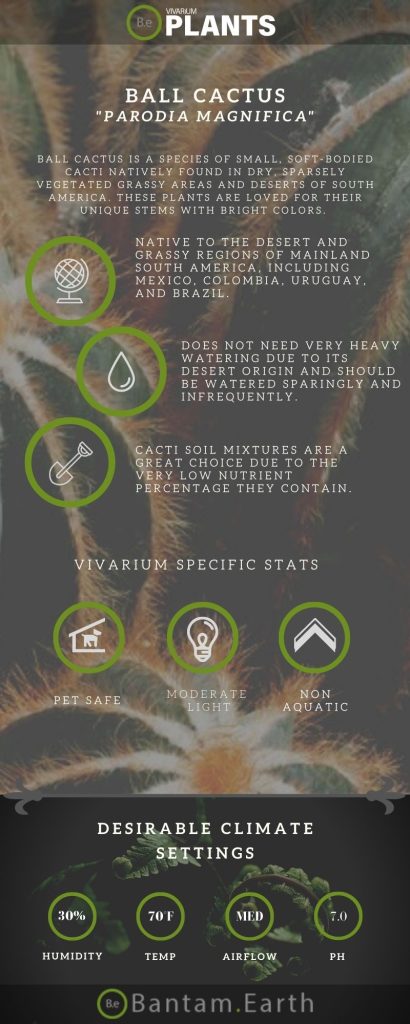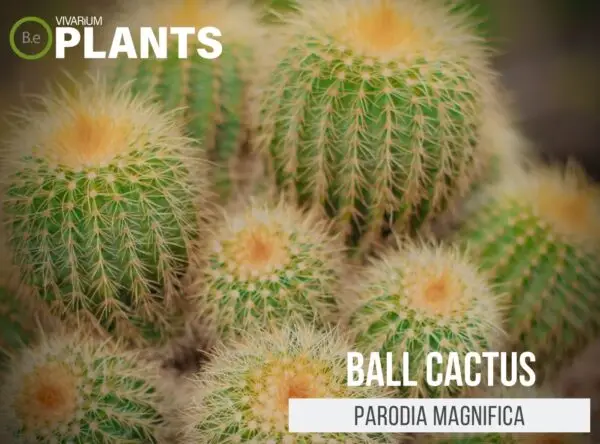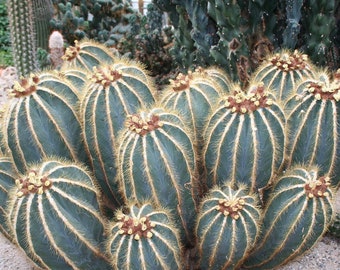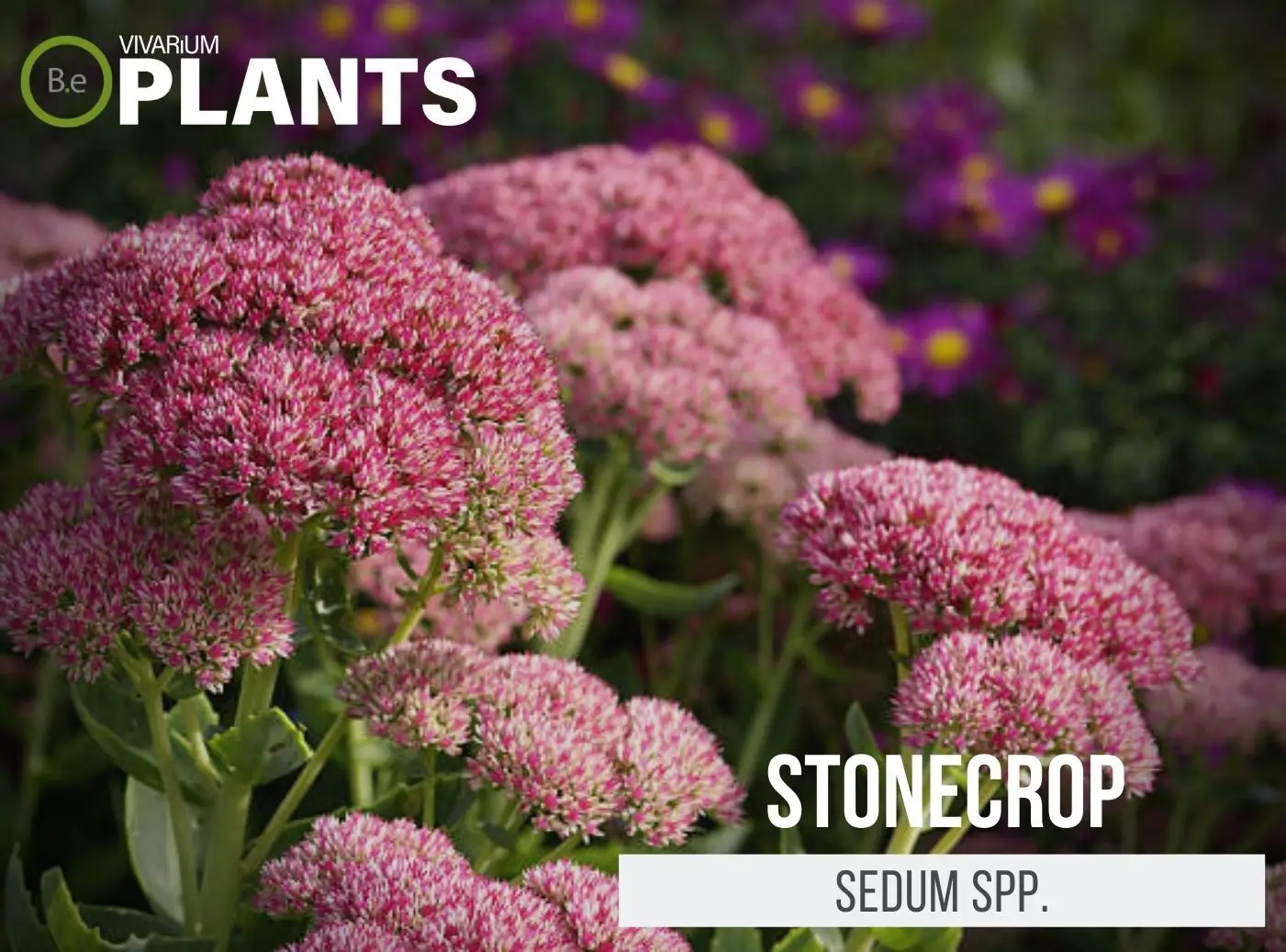Welcome to the world of succulent terrariums, where plants like the Ball Cactus (Parodia magnifica) take center stage and make a wonderful addition to any indoor or outdoor living space.
With its beautiful and unique shape, the Ball Cactus is the perfect way to add a touch of greenery and interest to your terrariums and small spaces.
In this article, we’ll discuss the care requirements and benefits of having this one-of-a-kind succulent in your collection.
| Quick Stats: | |
|---|---|
| Scientific Name | Parodia magnifica |
| Common Name | Ball Cactus, Pincushion Cactus |
| Family Name | Cactaceae |
| Habitat | Deserts & Grassy Areas |
| Temperature | 65°F to 85°F |
| Height | 4 to 8 inches |
| pH | 6.0 to 8.0 |
| Lighting | Moderate |
What is Ball Cactus?
Ball cactus is a species of small, soft-bodied cacti natively found in dry, sparsely vegetated grassy areas and deserts of South America.
These plants are loved for their unique stems with bright colors.
They can range from vivid purples to magenta, pinks, yellows, and deep green.
Their stems are a cushiony, round creation that looks like a small pillow and are armor-plated with anywhere from 2-4 long spines.


Ball Cactus Facts
Despite its delicate appearance, Parodia magnifica is surprisingly resistant to most animals, although some may eat the outer spines.
This cactus is incredibly easy to propagate by separating the junction between the stems and rooting them in the soil.
The stems of this plant will upscale in size with each repotting and create more aesthetic variety among taller plants and hardscape elements.
Description
Ball cactus has round, pillowy stems with a stem diameter of 4-8 inches and an average of 3-6 inches in height.
Different colors are present ranging from dark to light green and shades of purple, pink, and yellow.
They have very tough and long spines that range from 2-4 each with varying colors to match their stems.
Habitat
Parodia magnifica is native to the desert and grassy regions of mainland South America, including Mexico, Colombia, Uruguay, and Brazil.
The average temperature in its native area ranges, from 65-85℉ and exhibits excellent adaptability to common temperature fluctuation that is inevitable in vivariums.
pH Preference
Ball cactus is a fairly versatile cactus when it comes to pH.
It prefers soil on the more neutral side of the pH scale, ranging in ideal acidic levels from 6.0-8.0, and will wither away in soils lower than 6.0.
Vivarium Type
Ball cactus is quite an easy-going species.
With that in mind, it will not be too complicated when it comes to choosing the type of enclosure it is grown in.
It is best to try and replicate the plant’s natural habitat as much as possible.
Doing so will make it easier to provide this succulent plant with its basic needs.
The proper setup and theme of the enclosure will make a big difference to the overall look and health of the plant.
Here are recommended vivariums it will do well in:
-
- Terrariums – Fully terrain-based enclosures with little to no aquatic features.
Vivarium Placement
Parodia magnifica is a terrestrial cactus, so it will prefer to be planted in terrarium soil.
It should be placed wherever you feel is most suitable for aesthetic preference.
This cactus does thrive in direct sunlight but also loves being in shade and medium to bright indirect light.
Substrate
Ball cactus is accustomed to full-draining soils like clay.
Cacti soil mixtures are a great choice due to the very low nutrient percentage they contain.
Gravel or rock-based substrates are also viable options for this cactus.
Lighting
Parodia magnifica needs only moderate light intensity to thrive.
LED bulbs can be used to provide the right mix in the vivarium.
Fluorescent lighting is also suitable, but LED bulbs will be better at promoting both aesthetics and health in your terrarium.
Buy Ball Cactus
When it comes to buying ball cacti, there are a few things to keep in mind.
Making sure the plant is healthy when purchased is essential for its success in a vivarium.
Vegetation that is already in poor conditions will have a very hard time adjusting to new environments.
Click the image below to find out more about the current price and other relative info about this plant.
Ball Cactus Care and Propagation
Parodia magnifica is relatively easy to propagate when it has two or more stems that are separated by cutting the area in between them.
Place the separated stems into a damp potting mixture of sand and soil and keep them moist but not overly saturated.
The soil should be kept slightly damp until the cactus is completely rooted into the new soil.
How to Grow
Ball cacti should be fed a diluted mixture of cactus fertilizer once or twice a year.
Plant fresh soil during each repotting if necessary and avoid using soil mixtures with nutrients.
It is highly recommended to not mix this cactus in with other plants because it can be quite dangerous if other plants grow too close and intertwine their spines.
Watering
Parodia magnifica doesn’t need very heavy watering due to its desert origin and should be watered sparingly and infrequently.
During the spring and summer months, it’s best to water the cactus weekly and reduce the watering frequency during winter.
Make sure to evenly water the soil so it doesn’t get overly saturated.
Plants Similar to Ball Cactus
Adding diversity to an enclosure is key to an aesthetically pleasing setup.
Try mixing up the look of your vivarium with different flora that can easily co-exist in the same types of environment.
Furthermore, if for some reason you find ball cactus hard to acquire or would like to consider something similar to this plant…
Here are other succulents you might find will do well with or in the place of Parodia magnifica:
Conclusion
If you’re looking for a terrarium plant to add a unique and colorful appeal to your vivarium then Parodia magnifica is an excellent choice, especially if you want to try your hand at cacti.
It is the perfect centerpiece, whether planted low to the ground with other cacti or set off in a higher, brighter location.
Growing this cactus is quite easy and it adds a unique look and feels to any tank, as well as offering habitat possibilities for small invertebrates.
Frequently Asked Questions
Parodia magnifica is a species of cactus that can grow up to 8 inches (20 cm) in height and up to 10 inches (25 cm) in diameter.
Parodia Magnifica can be easily grown indoors or outdoors. To achieve the best results, it should be planted in a well–draining soil mix, watered regularly, and exposed to plenty of bright, indirect sunlight.
To encourage healthy growth, fertilize the plant every two weeks with a balanced liquid fertilizer diluted to half the recommended strength. Pinch back the tips of the stems to promote a bushier growth habit and keep the plant compact.
There are over 60 species of Parodia, a genus of cacti from South America.
A Parodia magnifica is a striking cactus with a globular shape and silvery–white spines. The stem is usually bright green and can reach up to 8 inches tall and 10 inches in diameter. The flowers are bright yellow and cup–shaped and appear in the spring.
The lifespan of a Parodia magnifica cactus is about 7–10 years.




